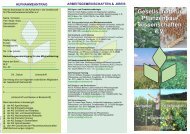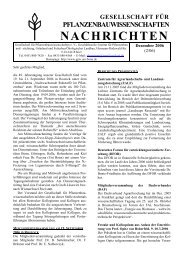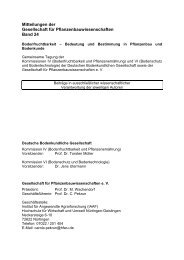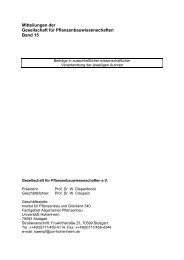Mitteilungen der Gesellschaft für Pflanzenbauwissenschaften Band 23
Mitteilungen der Gesellschaft für Pflanzenbauwissenschaften Band 23
Mitteilungen der Gesellschaft für Pflanzenbauwissenschaften Band 23
Erfolgreiche ePaper selbst erstellen
Machen Sie aus Ihren PDF Publikationen ein blätterbares Flipbook mit unserer einzigartigen Google optimierten e-Paper Software.
Mitt. Ges. Pflanzenbauwiss. <strong>23</strong>: 261–262 (2011)<br />
Fungal infection and its control in anise (Pimpinella anisum L.)<br />
results of two field experiments<br />
Habib Ullah and Bernd Honermeier<br />
Institute of Agronomy and Plant Breeding I, Justus-Liebig-University Gießen. E-Mail: Habib.Ullah<br />
@agrar.uni-giessen.de<br />
Introduction<br />
Anise (Pimpinella anisum L.) is an annual spice and medicinal plant belonging to the<br />
family of Apiaceae. Botanically, the seeds are defined as fruits containing around 1.5<br />
to 5.0% essential oil mainly composed of volatile phenylpropanoid like trans-anethole<br />
with more than 90% (Tabanca et al. 2005). Today, anise seeds are an important<br />
natural raw material which is used for pharmaceutics, perfumery, food and cosmetic<br />
industries (Ross, 2001). Aniseed plants can be infected by the fungal pathogen<br />
Cercospora malkoffii. The symptoms are characterized by cylindrical light brown<br />
spots with dark veins which can be found on leaves, stems and flowers. The infection<br />
starts at the lower parts of the plants at the un<strong>der</strong>side of the leaves. The seeds get<br />
dark color which comes from stomata of the fungus. The purpose of the present<br />
research was to evaluate the efficacy of various fungicides against the fungal<br />
infection un<strong>der</strong> the ecological conditions of (Hessen) in Germany.<br />
Materials and Methods<br />
The field experiments were carried out in 2009 and 2010 at the research station in<br />
Groß-Gerau (49 o 45´N and 8 o 29´E, 90.7 m above sea level, sandy soil, mean air<br />
temperature: 9.4 o C, mean precipitation: 590 mm/year). The experiments were<br />
designed as RCBD with four replications. Two cultivars Enza Zaden and Pharmasaat<br />
were planted with seed rate of 12 kg/ha in 1.5 x 7.0 m 2 plots with row spacing of<br />
18.7 cm. Five different fungicides were used: Folpet + Metalaxyl-M (2 kg/ha),<br />
Azoxystrobin + Difenoconazol (2x1.0 L/ha), Mancozeb+ Diemethomorph (2 kg/ha),<br />
Propamocarp (3 L/ha), Fosetyl (3 kg/ha) which were applied at different growth<br />
stages. After germination of anise 40 kg N/ha were applied in each year. The fungal<br />
disease severity on anise plants was recorded by grading 1-9 (1: without infection, 9:<br />
whole plants are infected). Visual fungal disease incidence was assessed for each<br />
plot fortnightly. The harvest was made by a combine harvester at the time of full<br />
ripeness of the fruits. Anise fruits were hydro-distillated for two hours using a<br />
distillatory apparatus of Neo-Clevenger. The essential oil was analyzed using a<br />
Varian CP-3800 gas chromatography equipped with flame ionization detector (GC–<br />
FID). A capillary column DB - 5 (30 m x 0.25 mm i.d. and 0.25 µm coting thickness)<br />
was used for the separation of individual components of essential oil.<br />
Results and Discussion<br />
Cultivars showed similar trend of planting densities in 2009, however higher<br />
germination was recorded by cv. Enza Zaden as compared with cv. Pharmasaat in<br />
2010. Anise plants were infected by the fungal pathogen Cercospora malkoffii in a<br />
range from 3.8 to 7.3 and 4.0 to 6.0 (level) respectively in 2009 and 2010, which led<br />
to brown colored leaf spots. Higher fungal infection was assessed in 2009 as<br />
compared to 2010. The study shows that fungicide applications had significant<br />
impact on fruit yield of aniseed in both years. Fungicidal treatments Folpet +







